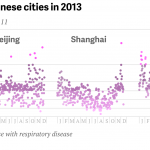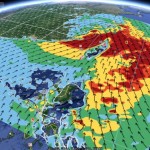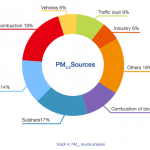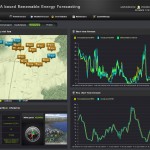How IBM is using big data to fix Beijing's pollution crisis – Quartz

Of China’s major cities, Beijing’s pollution problem is probably the worst, causing thousands of premature deaths every year. Its residents are fed up. The growing outrage has forced leaders to declare a “war on pollution,” including the goal of slashing Beijing’s PM2.5— the concentration of the particles that pose the greatest risk to human health—by 25% by 2017. The Beijing municipal government will earmark nearly 1 trillion yuan ($160 billion) to meet that target.
Tap to expand image
Why, then, are the city’s own government officials skeptical about hitting that 2017 goal? Perhaps because Beijing’s pollution woes are unusually complicated. The city is flanked on three sides by smog-trapping mountain ranges. There are numerous sources of foul air, and a multitude of subtle ways the chemicals interact with each other, which make it hard to identify what problems need fixing.
IBM thinks it can change that outlook. On Monday, the company will unveil a 10-year initiative to improve China’s national energy systems and protect the health of its citizens. Called “Green Horizon,” the project will focus on air quality management, renewable energy management and energy optimization among Chinese industries. As part of the initiative, IBM has already signed a partnership with the Beijing government, which is hoping to tap into the company’s expertise to help tackle the city’s air pollution crisis. IBM’s plan of attack involves some of the buzziest things in tech, including harnessing the processing power of “big data” as well as the “internet of things,” weather modeling, and supercomputing.
Tap to expand image
An IBM interactive visualization showing evolving temperature and wind directions over China.IBM
The Beijing government already collects air-quality data. Based on this information, it institutes emergency measures when PM2.5 concentrations rise too high, including closing factories, limiting the number of cars on the road and shutting down schools.
Tap to expand image
Sources of Beijing’s pollution as of 2006. (Car exhaust has likely increased since then.)Chinese Academy of Sciences, Greenpeace
The lack of a finer grain of data means the city’s pollution management is highly disruptive for both individuals and businesses, says Wang Tao, a climate and energy scholar at the Carnegie-Tsinghua Center for Global Policy. “If you don’t know exactly what is the source, how it’s interacting in the air and how it’s dispersing across the city it is more difficult to tackle it,” says Wang, who is unaffiliated with the IBM project. “What they really need is advanced technology and science to help them understand what measures must be taken.”
IBM plans to improve the quality of data by installing its latest generation of optical sensors, incorporating meteorological satellite data and running that through its artificial-intelligence computing system (a.k.a. Watson, that computer that trounced humans on Jeopardy). The visual maps it generates will identify the source and dispersal pattern of pollutants across Beijing with a street-level degree of detail 72 hours in advance.
The Green Horizon initiative will also see IBM use big data analytics and weather modeling to forecast availability of renewable energies like wind and solar, power sources that are notoriously intermittent. That should limit the amount of that energy being wasted. The third layer of the plan involves a system that IBM is developing to help industrial companies manage their energy consumption.
Tap to expand image
A sample user interface from IBM’s Hyref energy forecasting system. The display shows the predicted amount of renewable energy (graph on the right) generated by a wind farm (map on the left) based on current and forecast weather conditions.IBM
But at least in the short term, the air-quality monitoring focus could have a more immediate impact on Beijingers’ quality of life—in no small part because of what its partnership with IBM can do for the Beijing government’s credibility, says CTC’s Wang. Right now, a lot of Beijingers ignore measures designed to slash auto emissions—largely because they suspect that such policies are just a way to squeeze more tax revenue out of them.
“Even in Beijing, the general public doesn’t feel that confident about what the government tells it to do,” he says. Since “IBM is a renowned [for] advanced technologies [the government] will be able to improve the accuracy and the authority of the analysis. People will have to realize they are part of the problem to be part of the solution.”
In a way, that’s something that Dong Jin, one of IBM’s Bejiing engineers, is already seeing happening when he and his colleagues tell their families about their work.
“Even my eight-year-old boy is very excited when I mentioned what’s going on with the program and how it can help the city… have better air quality,” Jin says. “We live here. A lot of our families are here too. When we tell them what we’re doing—it’s a pressing need and they’re very excited.”
Link to article:
How IBM is using big data to fix Beijing's pollution crisis – Quartz




